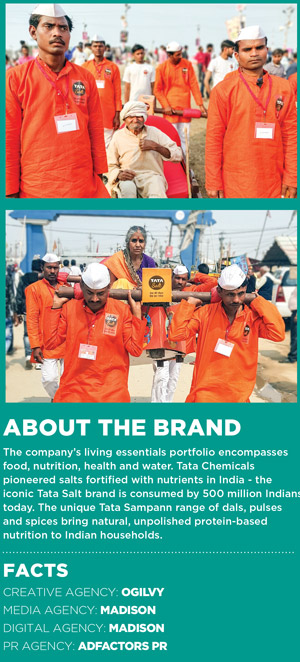One of the levers for Tata Salt is how we connect emotionally with consumers and brand love is one of our objectives. Rural and semiurban also happens to be the market where we want to extend our reach further. So, Kumbh was a natural choice. We essentially look at two things when we do activations; one is whether the brand can solve an issue in order to bring some value addition. Secondly, how can you integrate the role of salt to that? Here at Kumbh, we had one insight that people had to walk for almost 4 kilometers up to the ghat where ‘shahisnaan’ happened, as all vehicles were cordoned off beyond a point. And obviously, a significant amount of elderly people who visit found it difficult to commute to that place. Our idea was to make their journey a little more pleasurable and comfortable. And that is where the idea of ‘Kumbh ke shravan’ came up, where creatively we took up the mythological concept of ‘Shravan’.
Q] Has it really helped create the brand affinity that you were looking for?
Yes certainly. However, it is very difficult to measure affinity, because it is something you build for a longer term and it becomes a significant part of brand equity. But if you look at this particular campaign, around 1.5 crore people had visited the ghat that day, so the brand was positively visible to so many consumers. Secondly, its amplification on social media has been significant. We reached a million people on Twitter, a lot of them organically. Around 2,000 people re-tweeted our campaign and a lot of people commented positively on the idea.
Q] How open are people to brands in gatherings like pilgrimages? Is there a negative connotation attached to these brands?
It depends on what it is that you are doing. That’s where the authenticity of a brand comes into play. If your intentions are genuine and the solutions are authentic, people do look at it from a favorable point of view.
Q] Tata Salt is a legacy brand and has been around since ages now. How big is your challenge to extend the proposition forward?
Yes, Tata Salt is an iconic brand and touches the lives of around 65 crore Indians every single year. Our single biggest strategic lever is to convert consumers who are using local brands to Tata Salt. In line with that, a couple of years back, we re-looked at the brand positioning which was ‘DeshKaNamak’ to ‘DeshkiSehat, DeshKaNamak’. So now every offering that comes from the stable of Tata Salt has something which helps enhance the health of the nation. Be it Tata Salt regular, lite or plus. And all our communications talk about health benefits. If you look at Tata Salt’s last campaign, the idea was ‘Sawaal kijiye apne namak se’, wherein we speak about demonstrating how Tata Salt is better than using any other salt.
 Q] Tata has reached a level of maturity in its brand journey. Does it still need to talk about functionality of the brand?
Q] Tata has reached a level of maturity in its brand journey. Does it still need to talk about functionality of the brand?It is not necessarily true. While the brand has a very strong footprint in the metros and urban pocket, it still has a way to go in smaller towns and rural areas, where there is still room for adoption. I think we can definitely be much bigger than where we currently are. And that’s the premise where all our campaigns start. Secondly, in urban areas where we have a significantly higher position, we see a good opportunity in upgradation and augmentation.
Q] Salt itself is a low involvement category. Do consumers actually absorb the communication that you are passing through? Do they actually differentiate between these variants?
There are two biggest insights in the salt segment. Firstly, a salt is a salt, and that means consumers are apathetic towards the product. The second insight is that salt is bad for health. And these two insights also happen to be diametrically opposite to each other. And this is precisely what our role as a market leader in the category is. One is to help improve the involvement level in the category and also to talk about the health aspects of salt. Now we are going to take the positioning of ‘Desh ki sehat’ to the next level by talking about the right amount of iodine and compare it with the others. We are looking at the second insight by trying to give more options to the consumer through our variants.
Q] When it comes to the spices and instant mix category, most brands talk about taste, flavour and authenticity of a particular ‘masala’. So does Tata Sampann. How do you really differentiate yourself within the category?
Positioning of ‘sarvagun sampann’ comes from the Indian way of nutrition. According to Western thinking, health and taste are two polarities; if something is to be healthy, it would be less tasty. Whereas, the Indian way of nutrition is the philosophy of addition and not subtraction. And that is where the positioning really stems from. So, we talk about our spices being rich in natural oil and that health and taste can co-exist.
Q] What is your biggest challenge for Tata Sampann right now?
The biggest challenge is the adoption of the brand. We have seen that we have one of the highest loyalty rates. For most of the categories, we have a repeat rate of around 70. So getting the consumer to try our brand is the biggest challenge. Another challenge is to really look at our go-to market strategy that helps us reach our consumers where they want us.
Q] What has been the key learning in your role so far?
Both Tata Salt and Tata Sampann are different in their life stage, stature and objectives. However, strategically there are commonalities in both these brands as both are positioned around nourishment. So, the first learning is that if you have a genuinely good proposition, consumers will definitely want to adopt you and will stay with you. A positive word of mouth is the single biggest glue that can make a brand great. Secondly, authenticity is important, especially in the FMCG category. What you are proposing as an offering and what you actually deliver is genuine, your ability to attract the consumer increases. And the third is learning the power of synergy and a unified philosophy that glues different categories together.
























